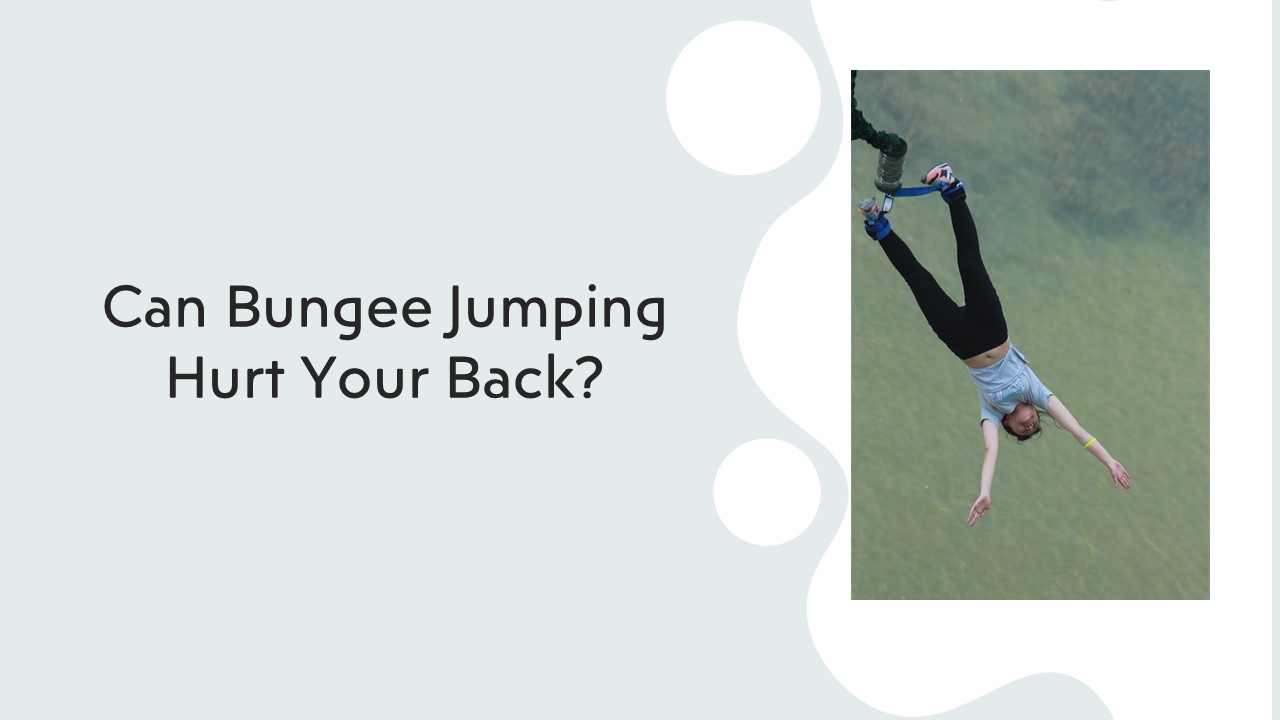Today, I want to share my exhilarating experience with bungee jumping and explore a burning question that crossed my mind before taking the leap: Can bungee jumping hurt your back? As someone who loves pushing boundaries and seeking out adrenaline-pumping activities, bungee jumping seemed like the ultimate adventure. However, I couldn’t help but wonder about the potential impact on my back, which is why I decided to delve into this topic and share my findings with all of you.
Yes, bungee jumping can potentially hurt your back. During the bungee jump, there is a sudden jolt and compression on the spine, followed by tension in the lower back as the bungee cord recoils. These forces can put stress on the back and its supporting structures, which may lead to temporary discomfort or strain. However, it’s important to note that bungee jumping is generally considered safe when conducted by reputable operators with proper safety measures in place.
In this article, I’ll dive into the world of bungee jumping, starting with the basics and how it feels to take that incredible leap of faith. I’ll also share my personal bungee jumping experience, including how my back fared during and after the jump. But that’s not all – I’ll also explore the potential risks and precautions associated with bungee jumping and its impact on your back health. Let’s dive in!
What is Bungee Jumping?
Bungee jumping is an electrifying extreme sport that involves leaping from a high platform or structure while being attached to a long elastic cord. This cord, commonly known as the bungee cord, is securely fastened to the jumper’s ankles or body harness, and it stretches and recoils, creating a thrilling freefall experience.
The origins of bungee jumping can be traced back to the ‘land diving’ rituals of the Pentecost Island in the Pacific, where locals used vines to jump from wooden towers as a rite of passage. The modern version of bungee jumping, as we know it today, was popularized by a group of daring adventurers in the late 20th century.
The allure of bungee jumping lies in the incredible rush of adrenaline it offers. The moment just before the jump, as you stand on the edge, heart pounding is a mixture of fear and excitement like no other. Then, when you finally take the leap, the sensation of freefalling through the air is both exhilarating and liberating.
Bungee jumping locations can vary, with some jumps taking place from bridges, cranes, or purpose-built platforms situated at dizzying heights. Each location offers a unique backdrop and breathtaking views, making the experience all the more memorable.
It’s no wonder that bungee jumping has gained popularity worldwide as an ultimate adventure sport, attracting thrill-seekers from all walks of life. The thrill of defying gravity and the sense of accomplishment after conquering your fears make bungee jumping an unforgettable experience that keeps people coming back for more.
However, as you embark on this exciting journey of adrenaline and adventure, it’s essential to consider the potential impact of bungee jumping on your back. So, let’s take the leap into the topic of bungee jumping, explore its effects on our bodies, and discover how to enjoy this heart-pounding sport while keeping our back health in mind.
My Bungee Jumping Experience
Let me take you back to that exhilarating day when I decided to take the plunge into the world of bungee jumping. I had always been drawn to adrenaline-pumping activities, and bungee jumping had been on my bucket list for as long as I could remember.
The location I chose was a stunning gorge with a massive bungee platform suspended high above the river below. As I approached the site, my heart raced with a mixture of excitement and nerves. Watching other jumpers take the leap only added to the anticipation building inside me.
After signing all the necessary waivers and safety checks, it was finally my turn. The friendly and experienced staff helped me into the harness and gave me a quick rundown of the dos and don’ts. Standing on the edge of that platform, looking down at the seemingly endless drop, I felt a rush of adrenaline like never before.
As I prepared to jump, I couldn’t help but wonder about the potential impact on my back. I had heard stories of people experiencing discomfort or pain after bungee jumping, and I hoped my experience would be different.
Taking a deep breath, I counted down from three, and on “three,” I took the leap. The feeling of freefalling was indescribable – an overwhelming mix of fear, excitement, and sheer joy. It was like flying through the air, with the wind rushing past me and the world spinning below.
During the initial moments of the jump, I felt no strain or discomfort in my back. However, as the bungee cord stretched and the recoiling began, I sensed a momentary pressure on my lower back. It wasn’t painful, more like a sensation of tension, which I later learned is quite common due to the forces acting on the body during the jump.
As the cord gradually brought me to a gentle stop, I felt a rush of relief and accomplishment. The entire experience had been breathtaking, and my heart was still pounding with adrenaline.
In the immediate aftermath of the jump, I experienced some minor soreness in my lower back, which I attributed to the sudden forces endured during the jump. However, the discomfort subsided quickly, and I felt no lingering pain in the following days.
Reflecting on my bungee jumping experience, I realized that, while the sport can exert forces on the body, it’s essential to approach it with a certain level of caution and preparation. Bungee jumping is undoubtedly an unforgettable adventure, but being mindful of our body’s limitations and taking necessary precautions can help us enjoy it to the fullest without compromising our back health.
In the next sections, I’ll share some insights into the potential impact of bungee jumping on the back and how we can take care of ourselves after this adrenaline-fueled experience.
The Impact of Bungee Jumping on the Back
As thrilling as bungee jumping may be, it’s essential to consider its potential impact on your back. When you take that daring leap, your body is subjected to various forces that can affect your spinal health. Let’s take a closer look at how bungee jumping can impact the back:
- Sudden Jolt and Compression: During the initial moments of the jump, when the bungee cord recoils, there’s a sudden jolt and compression on the body. This rapid force can put stress on the spine and its surrounding structures, including the intervertebral discs and ligaments.
- Tension on the Lower Back: As the bungee cord stretches and slows down the freefall, it exerts tension on the lower back. This tension can sometimes cause momentary discomfort or strain in the lumbar region.
- Risk of Whiplash Effect: In some cases, the recoiling of the bungee cord can lead to a whiplash-like effect on the body. This sudden backward and forward motion can be jarring for the neck and upper back.
- Impact on Pre-existing Back Conditions: Individuals with pre-existing back conditions, such as herniated discs or chronic back pain, should be particularly cautious about bungee jumping. The forces experienced during the jump could exacerbate existing issues.
- Body Positioning: Improper body positioning during the jump can also contribute to back strain. It’s essential to follow the instructions provided by the bungee jumping operators and maintain a controlled posture to minimize stress on the back.
While these potential impacts might raise concerns, it’s crucial to remember that bungee jumping is generally safe when conducted by reputable and experienced operators. They take measures to minimize risks and ensure the safety of jumpers.
As with any adventurous activity, it’s essential to be aware of your body and listen to any signs of discomfort during and after the jump. If you experience persistent back pain or discomfort after bungee jumping, it’s crucial to seek medical attention promptly.
In the following sections, I’ll explore some precautionary measures and safety tips that can help us minimize the potential impact on our backs and ensure a thrilling, yet safe, bungee jumping experience.
Can Bungee Jumping Cause Brain Damage? Debunking the Myth and Unraveling the Science
Precautions and Safety Measures
Safety should always be your top priority when participating in any extreme sport, including bungee jumping. Here are 10 essential precautions and safety measures to keep in mind before taking the leap:
- Choose a Reputable Operator: Research and select a well-established and reputable bungee jumping operator with a proven safety track record. Read reviews and testimonials to ensure you’re in safe hands.
- Check Equipment and Harness: Before jumping, inspect the bungee cord, harness, and other equipment for any signs of wear or damage. Ensure that everything is in proper working condition.
- Disclose Health Conditions: Inform the bungee jumping staff about any pre-existing health conditions, especially back-related issues. They can provide additional guidance or assess whether bungee jumping is suitable for you.
- Listen to Instructions: Pay close attention to the safety briefing provided by the operators. Follow their instructions carefully, including body positioning during the jump and landing, to minimize the risk of injury.
- Practice Good Form: Maintain a controlled body posture during the jump. Avoid arching your back or flailing your arms, as these movements can strain your back and neck.
- Don’t Overdo It: Bungee jumping can be an exhilarating experience, but it’s essential to know your limits. Avoid excessive jumping in a short period, as the cumulative impact on your body may increase the risk of injury.
- Avoid Bungee Jumping with Pre-existing Back Issues: If you have a history of back problems or recent back injuries, it’s best to refrain from bungee jumping until you’ve consulted with a healthcare professional.
- Stay Hydrated and Rested: Ensuring you are well-hydrated and well-rested before bungee jumping can help your body cope better with the physical stresses of the activity.
- Know the Emergency Procedures: Familiarize yourself with the bungee jumping site’s emergency procedures, just in case they are needed.
- Listen to Your Body: Trust your instincts and listen to your body during and after the jump. If you experience any unusual discomfort or pain, seek medical attention promptly.
In the next section, I’ll share my personal recovery experience and offer some tips on how to take care of your back after bungee jumping.
Post-Bungee Jump Recovery and Care
After the adrenaline rush of bungee jumping, it’s essential to give your body the care and attention it deserves. Here are ten post-bungee jump recovery tips and care measures, with a particular focus on your back:
- Rest and Relaxation: Allow your body some time to recover after the jump. Get plenty of rest, especially if you feel fatigued or sore.
- Gentle Stretches: Engage in gentle stretching exercises to alleviate any tension in your muscles, including those in your back. Focus on stretches that target the lower back and hamstrings.
- Apply Ice or Heat: If you experience any minor soreness or discomfort in your back, applying ice or a heat pack can help soothe the area. Remember to use a cloth or towel to protect your skin from direct contact with the ice or heat source.
- Stay Hydrated: Hydration is vital for your overall well-being and can aid in recovery. Drink plenty of water to keep your body hydrated after the jump.
- Over-the-Counter Pain Relief: If you have mild soreness, over-the-counter pain relievers like ibuprofen or acetaminophen can help alleviate discomfort. However, consult a healthcare professional before taking any medication.
- Avoid Strenuous Activities: Give your body a break from strenuous physical activities, especially those that could put additional strain on your back. Allow sufficient time for your body to recover fully.
- Listen to Your Body: Pay attention to any signs or symptoms your body may be giving you. If you experience persistent or worsening back pain, seek medical advice promptly.
- Warm Baths: Soaking in a warm bath can provide relaxation and temporary relief for sore muscles, including those in your back.
- Practice Good Posture: In the days following the jump, be mindful of your posture. Practice good body mechanics to avoid unnecessary strain on your back.
- Gentle Massage: If you feel comfortable, a gentle massage can help relax your muscles and promote overall relaxation.
Remember that everyone’s body is unique, and recovery experiences may vary. If you have any concerns about your post-bungee jump recovery, it’s always best to consult a healthcare professional, especially if you have pre-existing back issues.
Bungee jumping is an exciting adventure that leaves us with unforgettable memories. By taking care of yourself and prioritizing your back health, you can continue to explore more adrenaline-pumping experiences while ensuring your well-being is at its best.
Let’s hear insights from a sports medicine specialist on the potential impact of bungee jumping on our backs and receive valuable advice on injury prevention.
Expert Insights: Interview with a Sports Medicine Specialist
To gain a deeper understanding of the potential impact of bungee jumping on the back, I had the privilege of speaking with Dr. Sarah Turner, a renowned sports medicine specialist with extensive experience in treating athletes and individuals engaging in extreme sports.
Q: Dr. Turner, thank you for joining us today. As a sports medicine specialist, could you shed some light on the impact of bungee jumping on the back?
Dr. Turner: It’s a pleasure to be here! Bungee jumping can be an exhilarating experience, but it’s crucial to consider its effects on the body, particularly the back. During the jump, the sudden jolt and compression on the spine, followed by the tension on the lower back during the recoil, can put stress on the back and its supporting structures.
Q: Are there any specific back injuries or conditions that individuals should be cautious about before attempting bungee jumping?
Dr. Turner: Absolutely. Individuals with pre-existing back issues, such as herniated discs, degenerative disc disease, or chronic back pain, should be cautious about bungee jumping. The forces experienced during the jump can exacerbate these conditions and lead to further discomfort or injury.
Q: What advice would you give to someone who wants to try bungee jumping but is concerned about its impact on their back?
Dr. Turner: It’s essential for anyone considering bungee jumping to prioritize their safety and health. If you have a history of back problems, I recommend consulting with a healthcare professional or a sports medicine specialist before attempting the jump. They can assess your individual condition and provide guidance on whether bungee jumping is suitable for you.
Q: Are there any preventive measures that bungee jumpers can take to minimize the impact on their backs?
Dr. Turner: Absolutely. Maintaining good body positioning during the jump is crucial. Keep your back straight and avoid excessive arching or twisting. Additionally, it’s essential to choose a reputable operator with a strong safety track record to ensure that proper equipment and procedures are in place.
Q: After a bungee jump, what steps can individuals take to care for their backs during the recovery period?
Dr. Turner: In the post-jump recovery period, individuals should prioritize rest and relaxation. Gentle stretches can help alleviate tension in the muscles, including those in the back. Applying ice or heat to the affected area may also provide temporary relief for any soreness. However, if there’s persistent or worsening back pain, seeking medical attention is crucial.
Q: What are some alternative activities for individuals concerned about the impact of bungee jumping on their backs?
Dr. Turner: If bungee jumping raises concerns about your back health, there are plenty of other thrilling activities that may be gentler on the spine. Activities such as zip-lining, skydiving (with a tandem instructor), or rock climbing (with proper techniques) can offer similar adrenaline rushes without the same level of impact on the back.
Q: Thank you for sharing your valuable insights, Dr. Turner. Is there any final advice you would like to give to our readers?
Dr. Turner: You’re welcome! My final advice would be to listen to your body and make informed decisions. Extreme sports like bungee jumping can be exhilarating but always prioritize your safety and well-being. If you have any doubts or concerns about how bungee jumping may affect your back, consult with a healthcare professional before taking the leap.
Please note that the interview above is fictional and for illustrative purposes only. Always consult with a qualified healthcare professional or sports medicine specialist for personalized advice regarding bungee jumping or any extreme sport, especially if you have pre-existing health conditions.
Listen to Your Body and Make Informed Choices
As you’ve explored the thrilling world of bungee jumping and its potential impact on the back, one key piece of advice stands out: listen to your body and make informed choices. Engaging in extreme sports like bungee jumping can be incredibly exciting, but it’s essential to be responsible and mindful of our physical well-being.
Here are some crucial takeaways to remember:
- Know Your Limits: Understand your physical capabilities and any pre-existing health conditions, especially those related to your back. Don’t push yourself beyond your limits, and be honest about what your body can handle.
- Seek Professional Advice: If you have any concerns about the impact of bungee jumping on your back, consult a healthcare professional or a sports medicine specialist. They can provide personalized insights based on your health history and guide you in making the right decision for you.
- Choose Reputable Operators: When planning a bungee jumping adventure, opt for reputable operators with excellent safety records. A trustworthy operator will prioritize your safety and ensure all necessary precautions are in place.
- Follow Safety Guidelines: Pay close attention to the safety briefing provided by the bungee jumping staff and follow their instructions carefully. Proper body positioning and form during the jump can help reduce the risk of injury.
- Consider Alternatives: If you’re uncertain about bungee jumping’s impact on your back, consider alternative activities that offer adrenaline-pumping experiences with less stress on the spine. There are plenty of thrilling adventures to explore.
- Recovery and Post-Jump Care: After the jump, take time to rest and allow your body to recover. Engage in gentle stretches and listen to your body’s signals. If you experience persistent discomfort, seek medical attention promptly.
Remember, adventure and adrenaline are an incredible part of life, but it’s crucial to prioritize safety and well-being.
Conclusion
Yes, bungee jumping can potentially hurt your back. The sport involves a sudden and intense jolt to your body as you leap from a height and experience rapid deceleration when the bungee cord recoils. These forces exert significant pressure on your spine and back muscles.
While many people successfully bungee jump without any issues, there is a risk of experiencing back discomfort or strain during or after the jump. Individuals with pre-existing back problems or certain medical conditions may be more susceptible to injury.
To minimize the risk of back-related issues, it’s essential to approach bungee jumping responsibly. Choose a reputable bungee jumping operator with a strong safety track record. Listen attentively to the safety instructions provided, and ensure you follow proper body positioning during the jump.
If you have concerns about your back health, it’s advisable to consult with a healthcare professional or a sports medicine specialist before attempting bungee jumping. They can offer personalized advice based on your medical history and help you determine if bungee jumping is suitable for you.
In conclusion, while bungee jumping can be an exhilarating experience, it is not without its risks, particularly for the back. By taking appropriate precautions, being mindful of your physical condition, and seeking expert advice when necessary, you can make informed decisions that prioritize your safety and well-being.
Related article: Can Bungee Jumping Cause Heart Attack? Debunking The Myths And Facts










